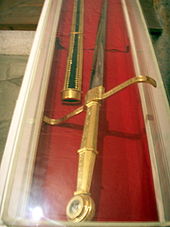Millstatt Abbey Museum
The Millstatt Abbey Museum is a museum located in Millstatt on Lake Millstatt , which deals with the history of the Millstatt Abbey and its former dominion in Upper Carinthia / Austria as well as Upper Carinthian mining. The museum, which is open from May to September, can be reached via the B 98 (distance to the Tauern Autobahn (A 10) / Spittal-Millstätter See junction 9 km).
The monastery museum is housed in several rooms directly around the Romanesque cloister of the monastery founded around 1070. The collegiate church, the historic town center and the lakeside are in the immediate vicinity. The museum, founded in 1981 by Franz Nikolasch from Millstatt , offers a comprehensive overview of the history of Millstatt, its surroundings and cultural assets related to Millstatt. The earliest traces of Upper Carinthian settlement from the Neolithic Age (approx. 4000 BC) such as the flint blade from Sappl on Millstätter Berg or the living pit at Schanzpichl near Lammersdorf are shown and documented . There are also finds from the Bronze and Iron Ages. B. from the Millstätter Alpe available. In Roman times , the Millstatt area was in the immediate catchment area of the town of Teurnia near St. Peter im Holz ( Lendorf ). The museum also has two exceptionally well-preserved marble doorsteps, remains of a luxurious Roman villa found in Dellach with red-green wall painting and hypocaust heating . The oldest preserved chalice in Austria (silver-plated copper, 5th century) comes from the excavations of an early Christian church in Laubendorf. The remains of the fortress on the Hochgosch near the Egelsee date from the Slavic period .
One focus is dedicated to Domitian of Carinthia , venerated as a saint , a Slavic tribal leader who lived at the time of Emperor Charlemagne and who converted a pagan sanctuary in Millstatt with numerous statues of gods ("mille statuae") into a Christian church. A rare Romanesque reliquary from around 1130/40 has been preserved. Of particular importance are the Romanesque sculptures on the main portal of the church and in the cloister of the Benedictine monastery, which flourished with the construction of a new monastery and church in the first half of the 12th century. In the second half of the 12th century there was a writing workshop in Millstatt, from which numerous important manuscripts emerged, including the famous Millstatt manuscript consisting of Genesis , Exodus and Physiologus . This composite manuscript, which is one of the most important early Middle High German works in Austria, is shown in numerous facsimile sheets in the Stiftsmuseum . Other works exhibited in facsimile are the Millstatt Giant Bible (11th century), the Millstatt Sacramentary (1170) and the Millstatt Psalter (1170). A Gothic panel with St. Catherine dates from 1440/50, probably part of a winged altar in the Millstatt collegiate church.
Numerous works of art are on display from the time of the Order of St. George , who took over the monastery in 1469. These include facsimiles of a number of precious manuscripts such as the prayer book of Johann Siebenhirter with particularly high-quality miniatures , the splendid antiphonary of the order as well as important incunabula from the early days of book printing and above all the famous prayer book of Emperor Maximilian I with pen drawings by A. Dürer , A. Altdorfer and L. Cranach. In 1495, after the death of his wife Paola Gonzaga , Count Leonhard von Görz gave the bridal chests designed by Andrea Mantegna to the Order of St. George Knights in Millstatt , one of which is on display in the museum. The official and ceremonial sword of the first Grand Master Johann Siebenhirter (South German, 1499) can also be viewed. The original is in the Landesmuseum Klagenfurt. There are also liturgical objects from Obermillstatt and Matzelsdorf in the museum .
A dungeon room that can be visited has scribbled inscriptions on the walls, which probably originate from the period between 1525 and 1550 by prisoners of the radical Reformation Anabaptist movement . In 1598 the Jesuit order took over the rule of Millstatt. Precious paraments and liturgical implements date from this time . In 1773 the Jesuit order was abolished, the entire property passed into state administration and led to the loss of important cultural assets.
A museum section gives an overview of the minerals, ore deposits as well as mining facilities and processing facilities in the Upper Carinthian area from the 15th to the 19th century with numerous mine maps and plans. Mineral finds from the south bank of the Millstättersee are particularly significant. a. represent Austrian and European first finds. The magnesite mining on the Millstätter Alpe is shown in detail.
swell
- ↑ Opening times (www.stiftsmuseum.at)
- ^ Axel Huber : Roman finds in the area of the Millstättersee. In: Symposium on the history of Millstatt and Carinthia. 2013. Franz Nikolasch (ed.). Pp. 45-87.
Web links
Coordinates: 46 ° 48 ′ 15 ″ N , 13 ° 34 ′ 15 ″ E




